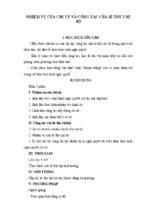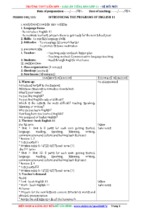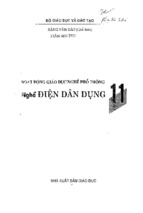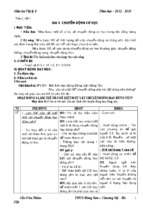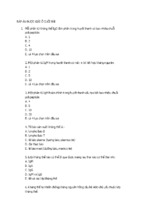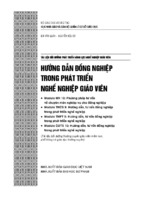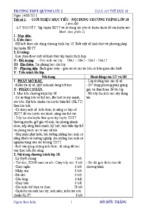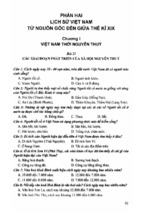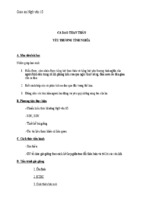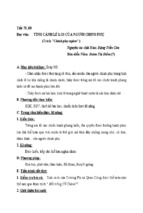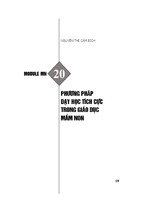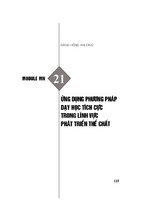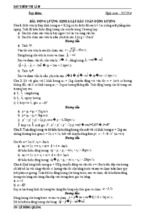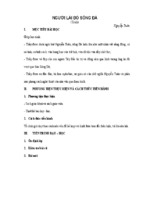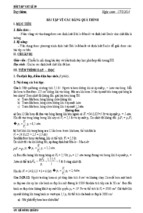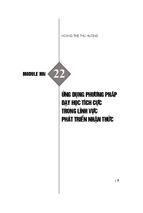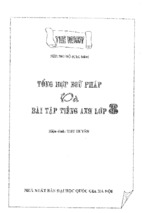PERIOD
UNIT 14: INTERNATIONAL ORGANIZATION
LESSON 5: LANGUAGE FOCUS
Teaching date: ……../……../2011
Aim: Intonation : The falling tune
Gram / Structure : Phrasal Verbs
Aids: Textbook, lesson plan
Time
PROCEDURE
Teacher’s activities
Content
Students’ activities
WARM-UP :
INTONATION :
Eg :
- What do you think of it ?
- What does ASEAN stand for ?
- giving some examples related
to the intonation and reading
them as the samples, then
asking Ss the question “What
intonation can I use in here : the
falling tune or the rising tune ?”
- giving the introduction
The falling tune
- listening to T
carefully,then
nswering
T’s
questions.
- listening to T
carefully,
then
repeating
them
individually.
- reading from sentence 1 to 8
as models.
GRAMMAR :
Eg :
after
chăm
for
up
tìm kiếm
tra từ
into
out
nhìn vào
nhìn ra,
at
nhìn,
sóc
trong từ điển
look
nhận biết
- listening to Ss exactly, then
correcting them.
- observing what T
- giving some examples related writes on bb.
to the PHRASAL VERBS
- giving the introduction and
definition.
ngắm
down nhìn
xuống
_ Phrasal Verbs : là cụm động từ
được theo sau bởi một giới từ nhất định
để có được một nghĩa khác (learn by
heart).
Answer keys :
Exercise 1 :
1. give up
6. look up
2. fill in
7. Turn off
3. turn on
8. fill in
4. take off
9. go on
5. wash up
10. Put on
Exercise 2
2. up
3. out
7. down
- taking notes, then
- supplying Ss the meanings of completing,
the given phrasal verbs in the comparing
and
box before asking Ss to do answering them.
exercise 1, 2, 3.
- writing Ss’ answers on bb,
then correcting them.
4. around
5. on
6. up
Exercise 3 :
2. look after
3. takes after
4. got over
off
5. held up
HOMEWORK :
PERIOD
8. away
9. down
10. on
6. try out
7. went
- asking Ss to learn by heart the
phrasal verbs and preparing
Unit 15 – READING.
UNIT 15: WOMEN IN SOCIETY
LESSON 1: READING
Teaching date: ……../……../2011
I Aim: By the end of the lesson, students can:
+ use dictionaries to look up the meanings of the words.
+ make intensive reading to find out information in the lesson.
+ practice reading skills such as skimming, clustering.
II Skills : reading ,speaking
III Aids: Lesson plan, textbook, available pictures, prepared pictures, other materials.
PROCEDURE
Time
Content
Teacher’s activities
Students’
activities
3’
I:WARM-UP:
Short conversation with a school girl about Making questions
Giving answers
her/her mother’s daily routines, activities at
home and in society.
II: PRE-TEACHING:
3’
A: Pre-reading:
Look at the pictures and answer the 1. Showing the pictures.
Looking at the
questions that follow: (page 162)
Asking
pictures and
a) How many roles does this woman have?
2. Asking students to look answering the
b) Is her life typical of a Vietnamese at the pictures at page 162. questions made.
woman’s life? Why / Why not?
making questions.
c) In your opinion, what is a typical
Vietnamese woman like?
Translation
8’
B: Pre-teaching vocabulary:
Translation
Following.
civilization (n) è civilize (v)
Translation
Listening and
deep-seated (adj): ăn sâu (vào tiềm thức),
Translation
repeating.
lâu đời.
Copying.
involvement (n) è involve (v)
Translation
Age of Enlightment (n.p): Thời đại khai
Explantions
sáng
philosopher (n) : nhà triết học
Synonym
pioneer (n): a person who is the first to do Translation
something.
advocate (v): agree, support: tán thành
Giving instructions
disciminate (v)è discrimination (n)
III: WHILE-READING:
Listening.
Read the passage and do the tasks as orders
Asking students to do
Reading. Doing
below:
Time
Content
8’
Task 1: Read the passage quickly and give
the Vietnamese equivalents to the words and
phrases. (page 163)
*(Students can use dictionaries to look up the
words’ meanings)
Key:
1: nền văn minh nhân loại.
2: việc sinh con, việc mang thai.
3: sự tham gia.
4: thời đại khai sáng.
5: những niềm tin ăn sâu vào tiềm thức.
6: việc chăm sóc gia đình.
7: năng lực trí tuệ.
8: cơ hội việc làm bình đẳng.
Task 2: Read the passage carefully and
choose the best option for each question. (page
164)
Key:
1:C
2:D
3:C
4:B
5:A
Task 3: Read the passage quickly and choose
the best title for the passage. (page 165)
Key: C: Women’s Rights.
8’
4’
5’
individually.
Students’
activities
the task 1.
Calling 8 students to give
the key
Giving the suggested key.
Giving the key.
Giving instructions
Asking students to do in
pairs.
Calling 5 students to give
answers
Giving the suggested key.
Giving instructions
Asking students to do in
groups of 3 or 4.
(Teacher’s explanations)
Giving instructions
Asking students to do in
groups of 3 or 4.
Giving the suggested key.
IV: POST-READING:
A: Work in groups. Summarise the reading
passage by writing ONE sentence for each
paragraph.
Suggested key:
1. In the past, women were restricted to the
role of mothers and wives due to the
widespread doubt about their intellectual
ability.
2. The struggle for the women’s rights began Giving command.
in the 18th century as European political
philosophers believed that women should be Giving comment
treated equally.
3. Women now enjoy important legal rights
such as equal work opportunities and equal pay, Giving assignment
the right to vote and to gain education.
B: Suggest a typical Vietnamese woman by
your own thoughts.
5’
1’
Teacher’s activities
Following and
taking notes.
Reading.
Giving answers.
Following and
taking notes.
Reading.
Choosing the
title for the
passage
Reading.
Writing.
Giving answers.
V: HOMEWORK:
Study by heart vocabulary.
Preview the next part (Speaking).
Write a short passage about your thought of
your female idol.
Listening and
taking notes
Listening and
taking notes
PERIOD
UNIT 15: WOMEN IN SOCIETY
LESSON 2: SPEAKING
Teaching date: ……../……../2011
I. Aims : By the end of the lesson, students will be able to improve their speaking skill and
know some expressions to give the opinions.
II. Skill : speaking
III. Vocabulary: noun, verb, adjective
IV. Teaching aids : pictures, posters, textbook…
PROCEDURE
Time
Content
Teacher’s activities
SS’activities
I.
WARM-UP : Matching game
4’
- Dividing class into2
-Listening to T’s
groups.
instruction
- Giving the instruction
- Matching the picture
with the number
- Checking and correcting - Checking
A
B
C
- Deciding the winner
10’
D
E
1.Washing the dishes
2. Washing the clothes
3. Cleaning the house
4. Cooking the meal
5. Going to the supermarket
* Keys: 1.E 2.D
3.B 4. A 5. C
II.
PRE -SPEAKING:
* Pre – teach Vocabulary:
+ neglect (v): sao l·ng
+ rear (v): nu«i dìng
+ slave (n) : n« lÖ
-Eliciting new words
- Situation
- Example
- Picture
-Listening T’s
instructions.
- Giving Vietnamese
meaning.
- Copying down
+nonsense(n) : sù v« lí
+ rubbish (n): vËt v« gi¸ trÞ
* Task 1 : Study the expressions and practise
saying them aloud ( p 165)
+ Giving your opinion
+ Strongly agreeing
+ Partly agreeing
+ Disagreeing
+ Strongly disagreeing
III.WHILE – SPEAKING :
- Translation
- Synonym
-Giving some expressions
to express the opinions
- Explaining
-Asking ss to practise
saying them aloud
- Listening and
repeating
- Listening to T ‘s
explanation
-Copying down
- Practising
15’
- Asking ss to work in
pairs and respond to these
statements in 10’
- Calling some pairs to
demonstrate
- Working in pairs in
10’
- Expressing
- Demonstrating
15’
- Explaning the task &
giving example
- Asking ss to work in
groups of 4 and discuss the
statement
-Calling some ss to
demonstrate in front of
class
-Writing on the blackboard
1’
- Listening T’s
explanation
-Working in groups of
4
- Discussing
-Demonstrating
-Taking note
V.POST – SPEAKING:
Task 3 : Discuss whether you agree or
disagree with the following statement and
give explanation (p166)
V .HOMEWORK:
- Review the learnt lesson
- Prepare the next lesson
PERIOD
UNIT 15: WOMEN IN SOCIETY
LESSON 3: LISTENING
Teaching date: ……../……../2011
I. Aims: by the end of the lesson, SS will be able to get a general view about a day of
African Women and improve listening-skill.
II. Skills : listening,Writing and Speaking
III. Vocabulary : saying,hold-up,agricultural,firewood,respect and africa
IV. Teaching aids : cassette,picture,poster and text
PROCEDURE
Time
Contents
Teacher’s activities
Student’s activities
3’
I/Warm-up(some picture)
Matching
- T sticks poster on the
-Ss look at the board
a.o
1.Vacuum cleaner
board
-Ss match
Asking
ss
to
devide
the
b.o
2.Washing Machine
class into 2 teams
c.o
3.Electrict cooker
-T corrects & decides what
d.o
4.Gas stove
team is the winner
12’
15’
II/ Pre-listening
Discuss the question
Is the life of a city woman easier than that
of a village woman nowadays ? why ?
* Pre teach-Vocabulary
-saying
-hold-up
-argricultural
-firewood
-Africa
-respect
-two-thirds
-three-fourths
III/ While-listening
Task 1.(page 167)
Key:
- T asks Ss to work in pairs
and answer the question
-Work in pairs and
answer question
-T asks Ss listen and repeat
-T explains fast meanings
and use of it
-Ss listen & repeat
-Take notes
-T explains the request of
the task & asks Ss to do it
- T plays the cassette
player two times
-T asks Ss to answer by
oral talk
-T correct
-Ss look into the task
before listening
-Ss listen and share
the answers with a
partner
1
2
3
4
5
B
C
C
A
B
Task 2 : Listen again then answer (poster)
Key :
1. 40 %
2. They earn nothing for doing their
domestic work
3. They produce more than half of the
food
4. 80 %
5. At 4.45 am
6. At 9.30 pm
13’
IV/ Post-Listening(poster)
Complete the table about a day work
An African woman
woman
FOOD
%
FARMWORK %
TIME BEGIN %
TIME FINISH%
2’
A Vietnamese
%
%
%
%
V/ Homework
- Learn by heart vob. & expression
-Practice listening again
-Prepare the writing
PERIOD
-Ss answer
-T guides Ss to look into
the task and guess the
answer before listening
-T plays the cassette player
two times
-T plays the cassette one
more time and stop after
each question
-T go around to help ,if
necessary
-T corrects
-T asks Ss to look at the
poster & works in pairs to
compare about a day work
of An africian woman with
A vietnamese woman
-Who do work harder than?
-T asks Ss to do at home
with contents in home
work
-Ss take notes
-Listening & guessing
them
-Ss work in
individually ,listen and
take note
- Listen carefully
-work in groups & compare
with friends
- Take note
-Ss look at the poster
& work in pairs
-Compare who do
work harder than ?
-Ss take notes
UNIT 15: WOMEN IN SOCIETY
LESSON 4: WRITING
Teaching date: ……../……../2011
I Aims :
By the end of the lesson, the students will be able to write a report describing the
information shown in the column chart
II Skills : writing ,reading ,speaking
III Teaching aids: textbook , poster ,pictures
PROCEDURE
Teacher ‘s
Time
Contents
activities
Warm up:jumpled word
-T giveS the
5’
rule of the game
- mairedr : married
-T corrects
- child baeirng : childbearing
-T gives the
- househlod : house hold
suggested
- nmuber : number
answers on the
child
crae:
child
care
10 ‘
board
I – Pre writing
task 1
T asks sts to
a Work in pairs :
work in pairs
- percentage of married men and married men
- roles of women and men in society
Students’
activities
Group A-B
Play game
Individual
of each
group
gives right
word
ss work in
pairs
15 ‘
14’
1’
- housework hours per week
b answer the questions :
Keys:
1 In general ,married women do more housework than men do
2 They have to do less house work when they have more
children .
3 Married men have to do less house work when they have
more children
4 Married men and women without children spend 20 and 30
hours on their housework per week respectively .
5 It takes men and women with one or two children 15 and 50
hours respectively to do their house work every week .
6 They are 10 and 55
7 Married men should spend more time sharing the housework
with their wives .
II While –writing
Task 2
Write a report describing the information shown in the column
chart in task 1 .begin your report
The column chart illustrates the average hours of housework
per week done by married women in comparison with married
men
III post –writing
Correction
Married women do more housework than men do
They have to do less house work when they have more
children
Married men have to do less house work when they have more
children
Married men and women without children spend 20 and 30
hours on their housework per week respectively .
Talking roles of women
IV Home work
Write a correct report at home
T elicits the
questions
Correcting the
answers
ss predict &
answer the
questions
T asks sts to
work in group
Sts work in
group and
then go to
the board
write down
corrects at least
4 reports
T sugests some
sentences
Ss note and
write down
Sts note
T helps to talk
Sts retell
T asks sts to do
at home
Ss must do
it at home
Study language focus at home
PERIOD
UNIT 15: WOMEN IN SOCIETY
LESSON 5: LANGUAGE FOCUS
Teaching date: ……../……../2011
I .Aim : - By the end of the lesson, the students are able to use intonation in yes / no
question .
- By the end of the lesson, the students are able to use and make the sentences
with preposition
II .Skills : speaking ,reading ,writing
III. Grammar / Structure : verbs, preposition
IV. Teaching Aids : Textbook, posters, chalk and board.
PROCEDURE
Time
Stages and Content
T’s activities
Ss’activities
Warm up :
3’
Matching column A with B
-T writes on board
-Sts guess and give
1 explain
a to
the answer
2 ask
b at
12’
10
10’
9‘
1’
3 talk
c about
4 glance
d for
1 Intonation
Are you students ?
Yes ,I’m
Practise reading the following sentences with
the rising tune
Work in pairs
Practise reading these conversations
1 and 2
2 Grammar
Setting the sence
What does he do ? You look at him
What does it mean ? you explain it to me
verbs go with preposition
Ex 1 choose one of the following verbs +
the correct preposition page 170
Key :
1 glanced at
2 invited to
3 listen to
4 throw at
5 staring at
6 speaking
7 wrote to
8 point to
Ex 2 : page 171
Fill in each of the planks with an appropriate
preposition if necessary
Key :
1 for
2 for
3 to
4 for
5 about
6 ____
7 about
8 _____
9 for
10 for
* complete the sentences with a proper
preposition
1 we wait ……. The bus
2 They live ………a small village
3 she arrives ………the air post
4 I ‘m interested …… reading
5 Tom talks …… her
* Homework
- learn words verbs go with prepositions
- prepare unit 16
PERIOD
- T checks and gives
points
- Sts observe
T asks ss to work
individually
T checks intonation
St reads at least a
sentence
T divides into 6 group
and then goes around
to help
Ss work in group
and practise reading
T sets the sence
What is it ? underlined
word
Ss look and predict
T asks ss to go to the
board
T Corrects form and
check meaning
Ss write it on the
board
T asks ss to fill in the
blank
Ss write down on
the board
T corrects it
Sts note
T sticks poster on the
board and asks ss to
fill preposition
Fill preposition in
the gap
T asks ss to do
Ss must do at home
UNIT 16: THE ASSOCIATION OF SOUTHEAST ASIAN NATIONS
LESSON 1: READING
Teaching date: ……../……../2011
I. Aims: -By the end of the lesson, students will be able to know the Association of Southeast
Asian Nations
-Know how to guess the meanings of the words from the contexts
-Know how to skim for main ideas
-Know how to scan for specific information
II. Lexical items: Words and phrases about the Association of Southeast Asian Nations
III. Teaching aids: textbook, teacher’s book, posters, and pictures
PROCEDURE
Time
Content
T’s activities
STS’ activities
3’
10’
23’
I. Warm-Up
Brain storming:
Southeast Asian countries
→Vietnam
→Thailand
→Laos
→
→
II. Pre-reading
1. Pre-questions: Pairwork
1. What does ASEAN stand for?
2. When did Vietnam join this association?
2. Pre-teach vocabulary
-to accelerate: to cause to move faster
→acceleration (n)
-to stabilize: lµm æn ®Þnh
→stability (n)
→stable (adj)
-justice (n) sù c«ng b»ng
-diverse (adj) gåm nhiÒu lo¹i kh¸c nhau
-to forge
→forgeability (n)
→forgeable (adj)
-to integrate: héi nhËp, hoµ nhËp
→integration (n)
→integrative (adj)
-enterprise (n)
*Checking: R.O.R
III. While-reading
1. Task 1: Fill in each blank with a suitable
word
Keys:
1. justice 2. GDP 3. diverse 4. integration
5. accelerate 6. enterprises
2. Task 2: Decide whether the following
statements are true (T) or false (F)
Keys:
1. T
2. F
3. F
4. T
5. F
6. F
3. Task 3: Comprehension questions→lucky
stars games
Keys:
1. The five original member countries, namely,
Indonesia, Malaysia, the Philippines, Singapore
and Thailand.
2. The two main goals of the Association are to
accelerate the economic growth, social progress
and cultural development; and to promote peace
and stability through respect for justice and the
rule of law in the relationship among countries
in the region.
3. It was about US$ 1405 billion.
4. It was adopted in 1998.
Explain
Play game
Lead sts to the point
Ask questions before
sts read
Answer questions
by guessing
Explanation
Translation
Translation
Translation
Translation
Guess the meanings
of new words
Contribute what
they know to T’s
presentation
Translation
Explanation
Work individually
Ask sts to fill in
the blanks by guessing
from the contexts
Ask sts to say T or F
and explain
Say T or F and
explain for their
choices
Work in 2 groups
Ask sts to play game
by choosing stars and
answering given
questions
Correct sts’ answers if
necessary
Give comments to
encourage sts’
participation
Try to be the
winners
Clap hands
5. It includes trade, investment, industry,
services, finance, agriculture, rural
development, forestry, energy, transportation
and communication, science and technology,
small and medium enterprises, and tourism.
7’
IV. Post-reading
Group work: summarise the passage, based on
the years: 1967, 1995, 1997, 1998, 1999, 2007,
2020
Ask sts to summarise
the reading passage
Ask sts to speak up
Work in groups
Choose 1
representative to
present
Individual work
Ask sts to work at
home
2’
V. Homework
-Write a paragraph about what you like or
dislike about the Association of Southeast Asian
Nations
-Be ready for Section B: Speaking
PERIOD
UNIT 16: THE ASSOCIATION OF SOUTHEAST ASIAN NATIONS
LESSON 2: SPEAKING
Teaching date: ……../……../2011
I. OBJECTIVE:
-By the end of the lesson, Ps will be able to tell the name, the capital and the basic
information about the facts of the ASEAN countries.
II. TEACHING AIDS:
- Book, pictures, flags, posters…
PROCEDURE:
Time
3’
8’
8’
Content
A.WARMER:
A group photo of the ASEAN leaders
-Set the scene of the lesson
* VOCABULARY:
- Buddhism ( n ): đạo Phật
- Catholicism ( n ): Thiên chúa giáo La Mã
- Christianity ( n ): đạo Cơ Đốc
- Islam ( n ): đạo hồi
- currency ( n ) : tiền tệ
- Baht( n): đồng bạt( đơn vị tiền Th¸i Lan )
- Peso ( n ) : đồng Pê-sô ( đơn vị tiền Philip- pin)
- Ringgit ( n ) : đồng ring-git ( đơn vị tiền
Ma- lay-xia)
B.PRE-SPEAKING:
Matching each national flag with the name
of the country and its capital.
FLAG
--
T’s actions
-show a group photo of
the ASEAN leaders
- Ask students to guess
what the photo means.
-
Ss’ actions
the photo of the
ASEAN leaders
Follow the steps - Listen & answer
for
presenting - Repeat
vocabulary.
- Copy
Check ROR
COUNTRY /CAPITAL
-
1.VIETNAM
2. MALAYSIA
3. THE PHILIPPINES
A. Thailand
-Bangkok
B. VIETNAM
- HANOI
C.Malaysia
- Kuala Lumpur
-
Ask ss to match - Match
each national flag individually and
with the name of then compare
the country and its
capital
Correct
4.THAILAND
5.SINGAPORE
6.INDONESIA
7.BRUNEI
8.LAOS
9.CAMBODIA
10.MYANMAR
15’
D. The Philippines
- Manila
E. Laos
- Vientiane
F.Indonesia
- Jakarta
G.Singapore
- Singapore
H. Cambodia
- Phnom Penh
I. Myanmar
- Naypyidaw
J- Brunei
- Bandar Seri
Begawan
C. WHILE-SPEAKING:
-Work in group: Discuss and use the
information in task 1 and facts below to ask
and answer about some of the ASEAN
countries.
MALAYSIA
Area: 330,252 sq. km
Population: 27,174,000
Official language(s): Malay, English, Tamil
Religion(s): Islam, Buddhism
Currency: Ringgit
(Malaysian dollar)
-
PHILIPPINES
Area: 300,000 sq. km
Population: 88,875,000
Official language(s): Filipino, English
Religion(s): Christianity
( mostly Roman Catholic)
Currency: Peso
THAILAND
Area: 513,120 sq. km
Population: 65,694,000
Official language(s): Thai
Religion(s): Buddhism
Currency: Baht
SINGAPORE
Area: 704 sq. km
Population: 4,589,000
Official language(s): Malay, English, Tamil,
Chinese
Religion(s): Islam, Buddhism, Hinduism,
Christianity
Currency: Singapore dollar
10’
D.POST-SPEAKING:
Talk about one of the ASEAN countries.
Ask ss to work in
group and make
questions
and -Work in group
answer about some -Make questions
of the ASEAN and answer in pairs
countries.
- Correct
ANSWERS
- QUESTIONS:
-Malaysia has a
1. What’s a total area of total area of
Malaysia?
330,252 sq.km
-Its capital is Kuala
2. What’s its capital?
Lumpur
-It has a population
3. What’ its population? of 27.174,000
- The official
4. What’s the official
languages used in
language used in
Malaysia are
Malaysia?
Malay, English and
Tamil.
5. What’s the main
-The main religions
religion in Malaysia?
in Malaysia are
Islam, Buddhism.
6. What’s the currency
-Ringgit is local
unit used in Malaysia?
currency in
Malaysia.
Malaysia has a total area of 330,252 sq. km.
Its capital is Kuala Lumpur. It has a population
of 27,174,000. The official languages used in
Malaysia are Malay, English and
Tamil………………………
1’
Ask ss to talk about
one of the ASEAN
countries on bb
Talk about one of
the ASEAN
countries
E. HOMEWORK:
PERIOD
UNIT 16: THE ASSOCIATION OF SOUTHEAST ASIAN NATIONS
LESSON 3: LISTENING
Teaching date: ……../……../2011
I. Objectives: by the end of the lesson, students are able to know more about the using of
English and religions in ASEAN nations.
II. Language content: vocabulary on religions
III. Teaching aids:
PROCEDURE
Time
Content
Teacher’s activities
Sts’ Activities
1. Warmer: Brainstorming
- Asking sts to play the - Playing the game
Vietnam
game
in groups
laos
- Checking
- Going to the
board to write
ASEA
N
nations
*
Key: Vietnam, Laos, Cambodia, Thailand,
Philipines, Malaysia, Indonesia, Singapore,
Brunei, Myanmar.
2. Activities:
- Making handouts and
* Activity 1: Pick out the countries in which asking sts to complete
English is used as the second language:
the task
Vietnam, Laos, Cambodia, England, The
USA, Thailand, Philipines, Malaysia,
Indonesia, Singapore, Brunei, Myanmar.
Key:
- Looking at
handouts and
discuss with a
partner.
- Giving the
answers
Philipines,
Malaysia,
Singapore, Brunei
* Activity 2: Listen to the tape and write out - Playing the tape,
religions mentioned in the dialouge
asking sts to call out the
Key:
religions they hear.
- Giving the correct
Buddhism, Islam, Catholicism
answers
* Activity 3: Listen to the tape and choose - Playing the tape 3
the best answer A, B or C to complete each times.
- Asking sts to look at
sentence
their book and listen to
1. Nga asked her father about_______
A. the English language spoken in the US. the tape.
- Asking Sts to share
B. people who speak English in the UK.
C.The number of people who speak the answers to a
partner.
English in the ASEAN countries.
- Listenning to the
tape
- Write out the
religions
- Giving the
answers
- Looking at the
book and
listenning to the
tape
- Choosing the best
answer
- Sharing with a
2.The ASEAN countries include______
A. about a quarter of a billion Muslims.
B. 25 million Muslims.
C. half a billion Muslims.
3. Muslims mostly live in ________
A. the Philipines.
B. Indonesia and Myanmar.
C. Indonesia and Malaysia.
4. The main religion in Vietnam is
__________
A. Buddhism.
B. Islam.
C. Catholicism.
5. Mr Hung thought that __________
A. he himself would wake up late the next
morning.
B. Nga would get up late the next morning.
C. both of them would wake up late the
next morning.
Key:
1 2 3 4 5
C A C A B
*Activity 4: Listen to the tape again and
answer the questions:
1. When will Nga sudmit the essay to her
teacher?
2. What country has the large number of
English speakers?
3. How many people speak English in the
ASEAN region?
4. Is English mostly spoken in Philippines?
Key:
1. Tomorrow( the next day)
2. The US.
3. Around 50 million.
4. Yes, it is.
* Activity 5: Listing religions in Vietnam:
Key: Buddhism, cao dai, Phat giao Hoa hao,
Catholicism, Islam….
3. Homework: summarize the content of the
dialogue between Nga and Mr Hung
PERIOD
- Checking
- Giving the answers.
- Playing the tape
sentence by sentence.
- Asking Sts to work in
groups.
- Checking the answer
partner.
- Giving the
correct answer
- Listening to the
tape
- Discussing with
friendsin groups.
- Answering the
questions
- Asking sts to work in
groups
- Telling the class
- Giving homework
UNIT 16: THE ASSOCIATION OF SOUTHEAST ASIAN NATIONS
LESSON 4: WRITING
Teaching date: ……../……../2011
I. Aims: By the end of the lesson, sts can know how to write a letter of recommendation.
II. Teaching aids: charts, pictures, …
PROCEDURE
Time
Content
T’ activities
Sts’
activities
I. WARM UP : Matching
1.
a. Ha Long bay
II. PRE WRITING
pick
the
- 2 groups
1. Complete the letter of
pictures up on
- matching
recommendation with
the board
2.
b. Da Lat
3.
c. Thien Mu pagoda
4.
d. Nha Trang city
5.
e. Trang Tien bridge
6.
Vung Tau
f. The beach of
7.
g. Van Mieu
the missing sentences in
the box. ( Task 1 –
p.180)
2. Outline
Date
Salutation
Body:
- location
- natural
features
- entertainment
- places to visit
- food
- people
- …………….
Closing
Signature
III. WHILE WRITING
David, your pen pal, is going to
spend his
Summer vacation in one of the
ASEAN countries. You want him
to visit Vietnam. Write a letter to
him recommending a significant
place you are familiar with. Use
the outline above.
IV. POST WRITING
Correction
- set the scene
V. HOMEWORK
Rewrite the letter.
Prepare LANGUAGE FOCUS
change
Keys: 1b 2c 3d 4g 5f 6e 7a
.
PERIOD
- ask sts to read - read and do
the letter and the task
complete
- correct
- correct
- think of a
- ask sts to significant
think
of a place
significant
- write an
place they are outline
familiar with
and write an
outline
- ask sts to
write
their
writing
- write a
individually
letter
- go around to
help sts if
necessary
- change the
paper
- ask sts to - correct
their
paper
- correct
- do at home
- give the task
UNIT 16: THE ASSOCIATION OF SOUTHEAST ASIAN NATIONS
LESSON 5: LANGUAGE FOCUS
Teaching date: ……../……../2011
I. AIM: By the end of the lesson, students will be able to know about the rising – falling
tone and the usage of tenses in the adverbial clause of time.
II. LEXICAL ITEMS:
III.TEACHING AIDS: textbooks, handouts, drill cues
PROCEDURES
Time
Stages & contents
T ’s activities
Sts’ activities
3’
5’
13’
15’
I. Pronunciation:
1.Picture:
Guessing the words through picture
IS IT FALL OR SPRING?
How can I speak this? Notice my voice, my intonation.
2. Practice : (tape recorder)
Listen and repeat:
1. Do you live in a house or in a flat?
2. Is Jane a teacher or a student?
3. Would you like some tea or coffee?
4. Is the baby a boy or a girl?
5. Shall we go by bus or by train?
6. Is today Tuesday or Wednesday?
7. Are you coming or not?
8. Is your sister older or younger than you?
9. Do you want to have lunch now or wait till later?
10. Did Italy or Brazil win the World Cup?
II. Grammar:
1. Presentation:
Matching:
ADVERBIAL CLAUSE
MAIN CLAUSE
OF TIME
1. He was sitting on the a. until she went to
beach
Tokyo last month.
2. The train had gone
b. as soon as we have
3. Remember to ask for finished this course in
permission
Boston University.
4. I have answered all
c. when he heard a noise
of the questions
d. as soon as his parents
correctly
went home.
5. She had never had a
e. before you light up a
chance to use her
cigarette
Japanese
f. since I began this
6. We can speak French grammar exercise on
well
verb tenses
7. Don’t go anywhere
g. till your parents come
8. Tom was playing
here
game online.
h. by the time we arrived
Key: 1c
2h
3e
4f
5a
6b
7g
8d
Form:
MỆNH ĐỀ
MĐ TRẠNG TỪ CHỈ THỜI
CHÍNH
GIAN
1.Simple present - Simple present (thói quen)
- Present progressive ( nhấn mạnh
hđ
Present perfect dang xảy ra)
(since)
- Persent perfect ( nhấn mạnh hđ
hoàn tất)
- Simple past
- present two
sounds
- listen and
answer
- guide Ss to
play the game
- control the
class
- lead to the
new lesson
- write the title
- listen
- take part in
the game
- play the tape
recorder
- ask sts to work
in pairs
- ask sts to
match the table
- present the
structure
listen & write
the title
- listen and
repeat
- pair works
- read and match
-listen and
answer.
- answer
- copy down
- ask sts for
concept check,
give the form
then
5’
2’
2. Future
- am/ is/ are
- Simple present
going to + Vo
- Persent perfect ( hđ hoàn tất)
- will/ shall +
Vo
- will have V3/
ed
3. Simple Past
- Simple Past ( thói quen)
- Past continuous (hđ đang xảy ra
ở qk)
Past
- Past perfect
continuous
- Simple Past
- Past continuous
Past perfect
- Simple Past
a. Không sử dụng thì tương lai trong mệnh đề trạng từ chỉ
thời gian.
b. MĐ TT chỉ thời gian được bắt đầu bằng các liên từ:
when
whenever
before
after
since as
as soon as
while
till/ until
just as
no sooner ...than
hardly ...when
as long as
2. Practice:
Exercise 1: Complete each of the following sentences,
using a suitable adverbial clause of time in the box.(p.182)
Keys:
1. She’ll phone you as soon as she arrives in Ho Chi
Minh city.
2. After the war was over, we started rebuilding the
country.
3. They met a lot of people while they were on
holiday.
4. Before you leave, don’t forget to turn off the
flights.
5. I’ll stay till you get back.
6. We’ll come to see you whenever we are in Hanoi.
7. There is a danger of war as long as imperialism
exists.
8. Tom sang a merry song as he walked away.
Exercise 2: Supply the correct tense form of the verbs in
brackets.(p.183)
Keys:
1. arrives
2. arrives
3. are playing
4.
got
5. have finished
6. (had) graduated 7. am
8.
have read
Exercise 3 :Combine two sentences, using one as an
adverbial clause of time with the given conjunction .
(p.184)
Keys:
1. Let’s go out before it starts raining.
2. I’ll give you my address when I have found
somewhere to live.
3. After he had done his homework, he went to bed.
4. We’ll let you know as soon as we have made our
decision.
- ask St to do
tasks
- go around for
helping
- correct
- work
individually.
- compare with
friend.
- listen and take
notes
- pair works
- ask sts to do
the exercises on
textbook
- listen and take
- ask sts to notes
compare with
friends
- correct
- do as directed
- ask St to
complete the
sentences
- check: “buy
the sentence”
- ask Ss to
make sentences
from the
pictures
- read , take
notes & give
feedback
-listen and take
part in the game
- do as directed
- work
individually
- compare with
friends
- listen and take
notes
- take notes &
do at home
- give the tasks
5. I haven’t met them since I left school.
6. Robert suddenly began to feel ill while he was
doing the examination.
7. Kate will come back home after she has finish the
last semester.
3. Production:
Make sentences from pictures
V. Homework:
- Learn by heart new language
- Xem thêm -

